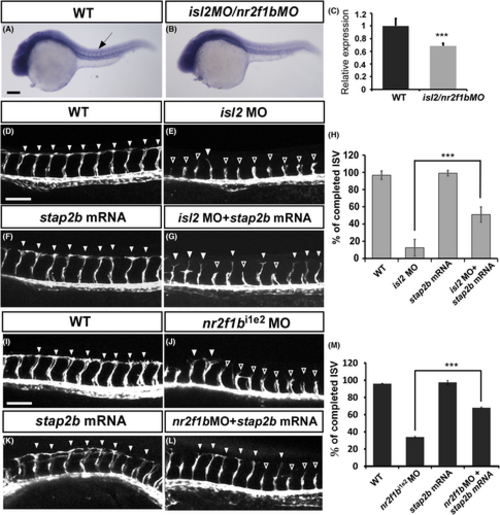Fig. 7
|
stap2b likely functions downstream of isl2 and nr2flb. (A and B) In situ hybridization showed that stap2b expression was reduced in isl2/nr2f1b morphants (B) compared to wild-type embryos (A). (C) Quantification of the relative expression level of stap2b in wild-type embryos and isl2/nr2f1b morphants. (D–G) Compared to uninjected wild-type Tg (kdrl:mCherry) embryos (D, n = 10), isl2ATG morphants showed an ISV growth defect (hollow arrowhead in E, n = 10). Injection of stap2b mRNA embryos (F, n = 10) showed completed ISV growth at 30 hpf, and coinjection of the isl2ATG morpholino with stap2b mRNA partial rescue the vascular defect in isl2ATG morphants (arrowhead in G, n = 10). (H) Quantification of the percentage of completed ISVs shows an increase of 40% in the embryos coinjected with isl2ATG morpholino and stap2b mRNA compared with that of the isl2ATG morphants at 30 hpf. (I–L) Uninjected wild-type embryos (I, n = 18) and injected stap2b mRNA embryos (K, n = 12) showed completed ISV growth at 30 hpf. Coinjection of the nr2f1bi1e2 morpholino with stap2b mRNA (arrowhead in L, n = 10) reversed the vascular defect in nr2f1bi1e2 morphants (hollow arrowhead in J, n = 14) at 30 hpf. (M) Quantification of the percentage of completed ISVs shows an increase of 34% in the embryos coinjected with nr2f1bi1e2 morpholino and stap2b mRNA compared with that of the nr2f1bi1e2 morphants. Scale bar are 200 μm for A and B, and 100 μm for D–L. Data are shown as means ± S.D. ***Refers to p < .001 by an unpaired Student's t-test. |

